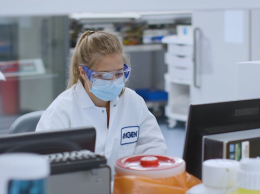Incoming Amgen chief Robert Bradway takes the baton from longtime CEO Kevin Sharer as the world’s largest biotech company makes critical decisions about how it will compete with Big Pharma and biosimilars.
Amgen, the Tri-Counties’ only blue-chip stock and the largest employer in the region with more than 6,000 employees, will install Bradway, a former Morgan Stanley investment banker, at its May 23 shareholder meeting in Westlake Village.
Analysts say Bradway takes the helm of a firm that is both entering the later stages of the company lifecycle — Amgen paid its first dividend last year — and is under pressure to develop new drugs or make acquisitions to fuel future growth, or even consider selling itself.
Cowen & Co. equity analyst Eric Schmidt said Bradway is “taking a very good company on very good footing.”
“If anything. Amgen has been criticized for being a bit boring these days,” he told the Business Times.
Although Thousand Oaks-based Amgen faces long-term challenges to remain competitive, investors have happily watched the firm’s stock price tick up about one-third since the company announced its first dividend payout last year.
But Sanford Bernstein analyst Geoffrey Porges warned earlier this year that if Amgen doesn’t develop new blockbuster drugs before its current offerings are forced to compete with what are known as biosimilars — the biotech industry’s equivalent of generic pharmaceuticals — it may become an acquisition target. “If nothing comes out of the pipeline, then the company is going to be rolled into a bigger, global diversified company,” Porges told news service Rueters in April. “That tends to be the nature of this industry. I don’t think the time is right for that now … but sooner or later investors are going to ask: What have you done for me lately?”
For years, Amgen has had sales of about $15 billion, generating consistent profits but lackluster stock performance. Late last year, it cut 380 research and development jobs — the bulk at its Ventura County headquarters — and issued a $5 billion share buyback.
Amgen’s biggest long-term challenge is the development of new products as competition for its current offerings heats up. The firm has struggled in recent years to develop new homerun products after federal reimbursement policies and labeling changes diminished sales of its biggest-selling anemia drugs. Its only megahit in the last five years has been denosumab, an osteoporosis treatment.
And most of the new products in its development pipeline are still in early-stage human testing mode. “Amgen has a relatively large and deep product pipeline, however, we do not think many of the products are good,” Stifel Nicolaus analyst Joel Sendek said in a March research report.
Amgen’s need for new products is especially acute given expected new competition for its best-selling products. To that end, it has gone into dealmaking mode with three acquisitions so far this year and a development agreement.
Amgen paid $1.2 billion for Micromet, a leukemia drug maker, earlier this year in its largest deal since 2005. In April, it announced plans to buy KAI Pharmaceuticals for $315 million in cash in a deal that would give it worldwide rights to an experimental treatment for patients with chronic kidney disease. And in late April, Amgen said it will buy Mustafa Nevzat Pharmaceuticals, a major supplier of pharmaceuticals and injectable medicines in Turkey. That purchase values the Turkish firm at $700 million and furthers Amgen’s push into international markets.
Meanwhile, an agreement with drugmaker AstraZeneca will share the cost of developing five of Amgen’s inflammation-targeting antibodies.
Amgen’s first-quarter earnings were flat at $1.2 billion. Revenue shot up 9 percent to $4 billion during the quarter on strong sales of Neulasta and Neupogen, which help protect against infection caused by chemotherapy, and Enbrel, a treatment for psoriasis and arthritis.
“The pipeline is developing well and the business is in good shape to address the opportunities and challenges ahead,” Sharer, Amgen’s outgoing chairman and CEO, said in a first-quarter earnings release.
Schmidt, the analyst with the Cowen & Co, said that the Bradway regime is likely to stick with a shareholder-friendly strategy of generous dividends. “The company has told us that over the next four or five years, they’ll be increasing the payout ratio as combination of stock repurchases and dividends to 60 percent of net income,” he said. Bradway would best serve shareholders by keeping costs in line and paying out profits, he said.
‘Change in compensation philosophy’
Bradway will receive a compensation package of $7.1 million in his first year in the top post, well below Sharer’s almost $19 million pay package last year.
In its most recent proxy statement, Amgen said that Bradway’s long-term incentive pay is at the median of his peer group. The reduction is in part to reflect Sharer’s 10-plus years with the company, but also reflects a “change in compensation philosophy” and is an effort “to be responsive to our stockholders,” Amgen said.
Combined pay for the company’s top three executives — Sharer, Bradway and CFO Jonathan Peacock — fell almost 10 percent last year to $31.7 million.
In his new role, Bradway’s base salary is slated to be slightly above the 30th percentile of his peer group, Amgen said, but his total compensation, including equity, will be just below that of his peers. Such “peer benchmarking,” defended by companies as a way to set an industry standard for pay and to reward talent, has also been criticized by advocates of executive pay reform as a way for firms to send c-suite salaries soaring.
Sharer’s compensation in 2011 dropped to $18.9 million from $21.4 million the year earlier, reflecting a drop in his stock options, rather than his base salary and cash bonuses.
[wikichart align=”center” ticker=”AMGN” showannotations=”true” livequote=”true” rollingdate=”6 months” width=”390″ height=”245″]





 Print
Print Email
Email

















